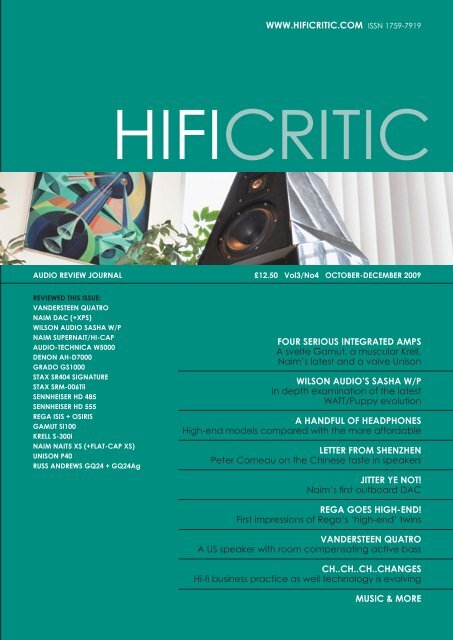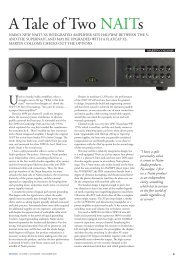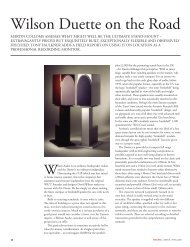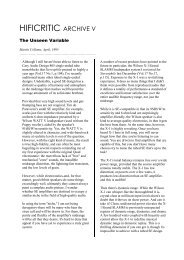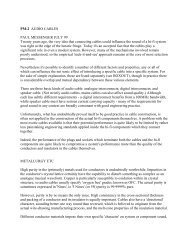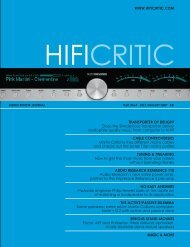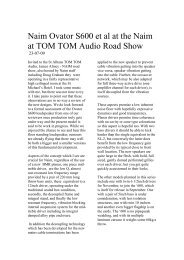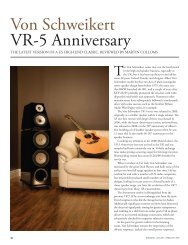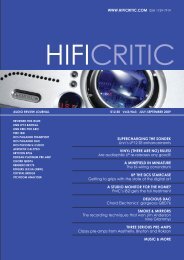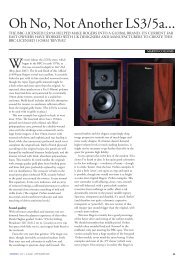HFC16_Krell reprint.indd - Hificritic.com
HFC16_Krell reprint.indd - Hificritic.com
HFC16_Krell reprint.indd - Hificritic.com
You also want an ePaper? Increase the reach of your titles
YUMPU automatically turns print PDFs into web optimized ePapers that Google loves.
WWW.HIFICRITIC.COM ISSN 1759-7919<br />
HIFICRITIC<br />
AUDIO REVIEW JOURNAL £12.50 Vol3/No4 OCTOBER-DECEMBER 2009<br />
REVIEWED THIS ISSUE:<br />
VANDERSTEEN QUATRO<br />
NAIM DAC (+XPS)<br />
WILSON AUDIO SASHA W/P<br />
NAIM SUPERNAIT/HI-CAP<br />
AUDIO-TECHNICA W5000<br />
DENON AH-D7000<br />
GRADO GS1000<br />
STAX SR404 SIGNATURE<br />
STAX SRM-006Tii<br />
SENNHEISER HD 485<br />
SENNHEISER HD 555<br />
REGA ISIS + OSIRIS<br />
GAMUT Si100<br />
KRELL S-300i<br />
NAIM NAIT5 XS (+FLAT-CAP XS)<br />
UNISON P40<br />
RUSS ANDREWS GQ24 + GQ24Ag<br />
FOUR SERIOUS INTEGRATED AMPS<br />
A svelte Gamut, a muscular <strong>Krell</strong>,<br />
Naim’s latest and a valve Unison<br />
WILSON AUDIO’S SASHA W/P<br />
In depth examination of the latest<br />
WATT/Puppy evolution<br />
A HANDFUL OF HEADPHONES<br />
High-end models <strong>com</strong>pared with the more affordable<br />
LETTER FROM SHENZHEN<br />
Peter Comeau on the Chinese taste in speakers<br />
JITTER YE NOT!<br />
Naim’s first outboard DAC<br />
REGA GOES HIGH-END!<br />
First impressions of Rega’s ‘high-end’ twins<br />
VANDERSTEEN QUATRO<br />
A US speaker with room <strong>com</strong>pensating active bass<br />
CH..CH..CH..CHANGES<br />
Hi-fi business practice as well technology is evolving<br />
MUSIC & MORE<br />
HIFICRITIC OCTOBER | NOVEMBER | DECEMBER 2009 37
<strong>Krell</strong> S-300i Integrated Amplifier<br />
A POCKET BATTLESHIP OF AN INTEGRATED AMPLIFIER BY MARTIN COLLOMS<br />
The very first thing that impressed me<br />
about this ‘first from China’ <strong>Krell</strong> (origin<br />
unambiguously printed on the rear panel),<br />
was the sheer mass of the packed unit: 23kg/51lb<br />
bodes well for build quality and for the large power<br />
rating of the mains transformer. The Editor is wont<br />
to <strong>com</strong>ment how often mass, or more specifically<br />
density, provides a useful guesstimate of possible<br />
loudspeaker performance, particularly when<br />
<strong>com</strong>paring like models in a group test. I have found<br />
that this can also be true for audio electronics, except<br />
where examples are deliberately built of special<br />
lightweight materials.<br />
The central volume rotary encoder has a<br />
secondary function as a control and data input<br />
for selecting various operating modes, many of<br />
which allow the user to customise the inputs, their<br />
sensitivity and channel balance offset if required, plus<br />
display dim and auto off functions.<br />
<strong>Krell</strong>’s KID iPod dock featured an analogue,<br />
balanced audio interface to an iPod’s multi-pin<br />
connection. Costing little more than the KID dock,<br />
the S-300i now includes a balanced ‘audio pod’<br />
connection, via a sufficiently long included cable,<br />
rather than a physical dock. Like the KID, it allows<br />
iPod album and track selection, play, pause etcetera<br />
via a dedicated keypad section on the main <strong>Krell</strong><br />
remote control. It’s helpful to be able to see the iPod<br />
screen while using these controls.<br />
<strong>Krell</strong> has provided some revealing data about the<br />
£2,400 S-300i which hints at the potential available.<br />
Good eco-friendliness is promised by the claimed<br />
low 20W standby power, despite the toroidal mains<br />
transformer’s large 750VA rating. However my VI<br />
meter contradicts this claim, measuring 42W/68VA<br />
on standby and 68W/104VA when ‘on’ at moderate<br />
volume (ie that of an average tungsten light bulb),<br />
and rather different from the spec. Nevertheless it is<br />
still quite low by audiophile product standards.<br />
On the basis that the mains transformer is<br />
larger than found in many good sized free-standing<br />
power amplifiers, the 2x150W 8ohms, 2x300W<br />
4ohms power output rating looks conservative,<br />
and I’d suspect that more like 200W and 400W/<br />
ch respectively will actually be available into real<br />
loudspeaker loads, making this a very powerful<br />
integrated amplifier indeed.<br />
This model’s US built predecessor, the KAV<br />
300i sold for about £3,000 in 1996, so the cost<br />
saving for the new build location has dealt a death<br />
blow to nearly 15 years of inflation. While the<br />
power output ratings for the old and the new are<br />
roughly <strong>com</strong>parable, the earlier design had four<br />
8,200uF Nichicon reservoir capacitors, a smaller<br />
450VA transformer, and idled at 50W. The new has<br />
four 4,700uF reservoirs per channel and of course<br />
that much larger toroid. There are double mono<br />
secondary supplies and reservoirs with four pairs of<br />
high current output transistors per channel. This is<br />
not a bridged design.<br />
The surface mount technology gives very short<br />
signal paths on the central circuit board. Control<br />
of DC offset for signal handling, in particular<br />
the fully balanced input, is allocated to a number<br />
of high precision Burr Brown OP177 op-amps.<br />
Also embedded is the 151-step analogue volume<br />
control, an FET-switched miniaturised surfacemount<br />
precision resistor ladder controlled via a<br />
microprocessor and a front panel rotary encoder<br />
volume knob. While miniaturised, <strong>Krell</strong>’s traditional<br />
discrete transistor symmetric array amplifier are<br />
present. These symmetric DC coupled very wide<br />
band stages are essentially immune from slewing<br />
with audio bandwidth signals.<br />
Build and finish is very good, like a standard <strong>Krell</strong><br />
EVO pre-amp. The power switch is on the rear panel<br />
next to the IEC mains connection, and the speaker<br />
terminal layout is sensible, with easy access ‘WBT<br />
38 HIFICRITIC OCTOBER | NOVEMBER | DECEMBER 2009
◆ REVIEW<br />
MARTIN COLLOMS<br />
style’ heavy duty binding posts, for wire, spade<br />
and 4mm plug connections. Some evenings a mild<br />
mechanical hum came from the casework: this may<br />
be the transformer’s magnetic field exciting the heavy<br />
duty steel panel casework, which is securely locked<br />
together by plenty of stainless steel socket-head bolts.<br />
Sound quality<br />
In recent years I hadn’t found the outgoing ‘300i<br />
very special musically, with barely above average<br />
rhythm and timing and an identifiable solid<br />
state quality, a leanness of timbre, some upper<br />
mid obscuration, and a sort of ‘blankness’ to the<br />
presentation. Right away I knew that the S-300i was<br />
a different and better amplifier. From the off there<br />
was an open and expressive vitality, a confident reach<br />
for dynamic expression, crisply focused definition<br />
and confident, assertive control of transient sounds<br />
right across the frequency range.<br />
Clearly not laid back, neither did it tip the other<br />
way to forwardness and brightness. The stereo depth<br />
plane was stable, just a little forward of the speakers,<br />
but with fine projection and depth. Focus was<br />
particularly good for the class, rivalling some more<br />
costly pre-/power <strong>com</strong>binations including some<br />
<strong>Krell</strong>s. Image width was decent, if not ‘super wide’,<br />
but groups of musicians appeared well located and<br />
remained locked in position.<br />
While it could not be confused with a valve<br />
amplifier, its timbre was substantially neutral,<br />
generally well balanced and focused, and natural<br />
and tidy in the treble. The bass sounded solid,<br />
powerful and deep, but just a hint of nasality was<br />
heard through the upper mid, the sound on strings<br />
showing a touch more ‘rosin’ than our assumed<br />
perfection.<br />
It could kick hard and play really loud into loads<br />
above 3ohms. The big three-way Eidolons presented<br />
no difficulties whatsoever, and this amplifier’s<br />
dynamic performance and headroom characteristics<br />
were more like those of a significantly more costly<br />
and substantial amplifier, punching well beyond<br />
its weight. Added to this is an inherently lively<br />
and upbeat nature that rates better than much of<br />
the <strong>com</strong>petition on rhythm and timing, moving<br />
significantly towards the involvement we take for<br />
granted from a number of Naim designs. Percussion<br />
has a realistic ‘snap and crack’, where other amps in<br />
this class can sound a bit muted and lacking drive.<br />
Setting the display to ‘auto mute’ added another few<br />
marks, and this amplifier certainly merits care taken<br />
with cable selection, routeing and dressing. With its<br />
overall precision, clout and clarity, the S-300i gains a<br />
very creditable 45 marks for overall sound quality.<br />
Out of curiosity I also tried the iPod interface,<br />
and the <strong>Krell</strong> handset successfully operated the iPod<br />
controls. Sound quality was fairly good (and even<br />
better with the main CD player disconnected – some<br />
interaction perhaps). Although I fancied that I still<br />
preferred even a cheap Panasonic battery CD player<br />
to those carefully recorded full res WAV files replayed<br />
via my Apple Classic, it was certainly useable for<br />
mood music and for less critical situations.<br />
Some critics have <strong>com</strong>mented on a slight<br />
background hiss from this amplifier. I found that it<br />
was at a low level, and did not vary much with the<br />
volume setting, and was not significantly audible<br />
with my 87dB/W Eidolon Diamond speakers at my<br />
normal 3.5m listening distance. However, some<br />
might hear it faintly if closer in, and also with higher<br />
sensitivity speakers say 90dB/W or more. I would<br />
leave out sensitive horn designs for this reason but<br />
check this out with your dealer.<br />
Lab report<br />
The output is generous, and on test still more than<br />
claimed, eg 2x190W 8ohms both channels driven<br />
and 324W into 4ohms. The very decent 16.5A<br />
peak current can drive 3ohm minimum speaker<br />
loads to full (4ohm) rated power. Feeding 2ohms,<br />
the protection folds back the output to 248W.<br />
Maximum per channel short term music duty<br />
cycle outputs were 225W 8ohm, 425W 4ohm, and<br />
260W 2ohm. Overdrive of even 6dB remained clean<br />
without latching or other misbehaviours, even up<br />
to 300W 8ohms at 20kHz. Transformer mechanical<br />
hum was low, though there was a trace of hum in the<br />
electrical noise floor.<br />
For a typical 10W swept distortion graph, most<br />
of the frequency range measured at the inherent<br />
noise level of 0.04% or -75dB, while for what it’s<br />
worth the intrinsic distortion is substantially less (see<br />
graphs). For example the two tone CCIF 19/20kHz<br />
intermodulation scored -83dB at 1W power and<br />
-88dB at 150W. The intrinsic frequency response<br />
is wide, barely -0.2dB at 10Hz and 20kHz, while<br />
the half power high frequency -3dB point is up at<br />
110kHz. Output impedance averaged a low 0.1<br />
ohms, a little less in the midband, while DC offset<br />
was also low.<br />
At volume setting ‘98’ rel 1W, the signal-tonoise<br />
ratios were certainly poorer than average with<br />
53dBA, 44dB CCIR (1kHz) and 48 dB unweighted,<br />
though supply hum levels were low. I cranked up the<br />
input level and with a more normal setting of 49 got<br />
70dBA, 70dB unweighted, and 60dB CCIR which is<br />
satisfactory.<br />
Input overload occurs at 5V, +20dB IHF, so do<br />
not apply those few high output sources (some CD<br />
players, for example). Input impedance is a very<br />
“From the off there was<br />
an open and expressive<br />
vitality, a confident reach<br />
for dynamic expression,<br />
crisply focused definition<br />
and confident, assertive<br />
control of transient<br />
sounds right across the<br />
frequency range”<br />
HIFICRITIC OCTOBER | NOVEMBER | DECEMBER 2009 39
HIFICRITIC<br />
Awards<br />
BEST BUY 2009<br />
<strong>Krell</strong> S300i<br />
source friendly 110kohm, with 130pF of shunt<br />
capacitance. Channel balance at higher settings was<br />
accurate within 0.047dB at 20kHz, and generally<br />
about 0.08dB overall. The volume control has<br />
occasional missing codes where a ‘click’ does not<br />
result in a volume change, and where the resolution<br />
varies with level. At high settings you get 0.5dB<br />
steps; in the ‘30s’ the steps are 0.8dB, with larger<br />
steps at very low volumes. This is not untypical of<br />
these ladder type controls.<br />
Channel separation was an average and more<br />
than satisfactory 67dB at 1kHz and 47dB at 20kHz.<br />
Output impedance was a very low and consistent<br />
0.13ohms over the frequency range. Output DC<br />
offset was also low, with about 10mV of c1Hz low<br />
frequency servo or related noise.<br />
One minor defect concerned the screws holding<br />
the rear power switch bracket which were loosening<br />
on this well used example. Lock washers might be<br />
helpful on this fitting.<br />
on to the customer, providing greater value for<br />
money. Taking everything into account: huge power,<br />
good load drive, technical accuracy, an intelligent<br />
iPod control interface, confidence inspiring build and<br />
finish, the channel balance and source volume offset<br />
facility, plus the precision volume control, it is well<br />
on the way to re<strong>com</strong>mendation. I consider it can<br />
operate <strong>com</strong>fortably as part of <strong>com</strong>plete hi-fi systems<br />
costing up to £15,000.<br />
Add in class leading sound quality (for power<br />
and price), with a focused, muscular delivery, good<br />
clarity and image depth plus tonal neutrality, good<br />
dynamics, above average rhythm and timing, plus<br />
a stunning dynamic range, and this is a thoroughly<br />
re<strong>com</strong>mendable, all purpose design. Even the<br />
handset is top quality.<br />
<strong>Krell</strong> S300i Frequency Response; 10W 8ohm, and<br />
distortion (green) RHS<br />
Conclusions<br />
Quality has not been <strong>com</strong>promised here by Chinese<br />
build, and the cost advantage has largely been passed<br />
INTEGRATED AMPLFIER TEST RESULTS<br />
Make ________________________________________________________________________________________<br />
<strong>Krell</strong> Date 22/10/09<br />
Model ________________________________________________________________________________________<br />
S-300i Ser. No. 231080800079<br />
POWER ________________________________________________________________________________________<br />
OUTPUT 20Hz 1kHz 20kHz<br />
Continuous ________________________________________________________________________________________<br />
8 ohm 2 channel 190 W 190 W 188 W<br />
Continuous ________________________________________________________________________________________<br />
4 ohm 1 channel 320 W 324 W 318 W<br />
Pulsed ________________________________________________________________________________________<br />
2 ohm 1 channel<br />
248 W<br />
Output ________________________________________________________________________________________<br />
impedance (ohms) 0.15 ohms 0.13 ohms 0.14 ohms<br />
Peak ________________________________________________________________________________________<br />
Current<br />
16.5 A<br />
Distortion, ________________________________________________________________________________________<br />
THD inc. noise (1W) >-88 dB -92 dB -82p dB<br />
Distortion, ________________________________________________________________________________________<br />
THD inc. noise (rated power)<br />
-76 dB<br />
Channel ________________________________________________________________________________________<br />
separation 70 dB 67 dB 47 dB<br />
Intermodulation ________________________________________________________________________________________<br />
Distortion 19.5kHz/20.5kHz 1:1 rated power, 8 ohms<br />
-88 dB<br />
Intermodulation ________________________________________________________________________________________<br />
Distortion 19.5kHz/20.5kHz 1:1 1W, 8 ohms<br />
-83 dB<br />
Signal ________________________________________________________________________________________<br />
to noise ratio (ref. 1W output) CCIR Weighted Unweighted A-weighted<br />
IHF. ________________________________________________________________________________________<br />
0.5V Aux 65 dB 70 dB 74 dB<br />
________________________________________________________________________________________<br />
Disc mm<br />
n/a<br />
________________________________________________________________________________________<br />
Disc mc<br />
n/a<br />
Channel ________________________________________________________________________________________<br />
Balance over volume range<br />
R ________________________________________________________________________________________<br />
ch is reference at 0db<br />
0.08 dB<br />
________________________________________________________________________________________<br />
at –20db<br />
N/A dB<br />
________________________________________________________________________________________<br />
at –40dB<br />
0.05 dB<br />
________________________________________________________________________________________<br />
at –60dB<br />
0.03 dB<br />
Frequency ________________________________________________________________________________________<br />
Response: +0,- 0.2dB 10Hz to 20kHz, -3dB at 110kHz<br />
Absolute ________________________________________________________________________________________<br />
Phase<br />
correct<br />
Input ________________________________________________________________________________________<br />
Data Socket Sensitivity Loading<br />
Aux ________________________________________________________________________________________<br />
input balanced - - mV - ohms - nF<br />
Aux ________________________________________________________________________________________<br />
input single ended (full power)<br />
________________________________________________________________________________________<br />
Phono or DIN 820 mV 110k ohms 130 pF<br />
Disc ________________________________________________________________________________________<br />
mm Phono or DIN - mV - ohms nF<br />
Disc ________________________________________________________________________________________<br />
mc Phono - uV ohms nF<br />
DC ________________________________________________________________________________________<br />
offset Left 10 mV Right 10 mV (VLF servo noise) (1-2 Hz )<br />
Size ________________________________________________________________________________________<br />
W x H x D (weight 19.5kg) 438 mm 102 mm 445 mm<br />
Price ________________________________________________________________________________________<br />
£2,400<br />
Contact Absolute Sounds Tel: 0208 971 3909<br />
www.absolutesounds.<strong>com</strong> www.krellonline.<strong>com</strong><br />
<strong>Krell</strong> S300i 10W CCIF distortion spectrum 8ohm load,<br />
an excellent result<br />
<strong>Krell</strong> S300i 1W 1kHz distortion spectrum 8ohm load,<br />
low order ‘odd’ harmonics dominant<br />
40 HIFICRITIC OCTOBER | NOVEMBER | DECEMBER 2009


